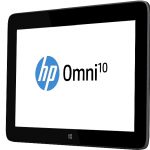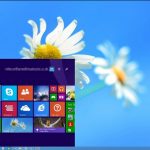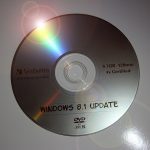Another Windows security reprieve -- Microsoft gives 8.1 users a further month to install Update

Windows 8.1 Update makes the tiled operating system more mouse and keyboard friendly, and while it takes a little getting used to at first, the changes are mostly for the better -- in my opinion anyway.
Microsoft has made the update mandatory, and in an effort to ensure people install it swiftly (thus avoiding the situation where there are customers out there running Windows 8, Windows 8.1 and Windows 8.1 Update) made it even more essential by stating that all future security patches, starting with those released tomorrow as part of Microsoft's monthly "Patch Tuesday", will require Update to be installed. In other words, if you haven’t installed the Update, your system could be at risk.
Ads in your browser? Sponsored landing pages could appear in Mozilla

Using the internet and being subjected to advertising very much go hand in hand. Sites have server bills to pay as well as other costs, and this is offset by displaying ads as a means of generating income. This is something we're all used to, and it's generally accepted as the price we have to pay. With the spread of mobile apps, the notion of advertisements within software becomes more and more popular, but, while not entirely unknown, it's not a notion that really translated to the desktop. This could be set to change if Mozilla's experiments with in-browser advertising come to fruition.
Of course, referring to it as advertising would be a little off-putting, so the word 'sponsored' is being thrown around in its place. What's all this about? Well, back in February Mozilla's Head of Content Services, Darren Herman, posted a blog entry outlining the company's 'Directory Tiles' idea. What this amounted to was a suggestion that in future versions of Firefox, the new tab page could feature "sponsored content from hand-picked partners" as well as links to site based on location. Herman gave the reassurance that "sponsored tiles will be clearly labelled as such" but, ultimately, it still amounts to in-browser advertising.
The most popular stories on BetaNews this past week: May 4 -- May 10

What's that? It's the end of the week already? How did that happen?! Things got off to a slightly slow start, but it ended up being another jam-packed seven days. Microsoft was criticized for continuing to patch Windows XP after support was supposed to have ended, but it does seem as though usage is starting to decline. Interestingly, it is Windows 7 that suffered from a higher malware infection rate according to Microsoft's Security Intelligence Report. Windows 8.x is still struggling to gain a large audience and Wayne looked at why this is the case -- maybe a smartwatch would be a smart move.
The effects of Heartbleed are still being felt, and ExtraHop Networks had some advice during a Q&A session. Symantec unveiled its security roadmap for Advanced Threat Protection, and Dropbox discovered a vulnerability that led to the company pulling access to hyperlinked files. Many big names came together to try to make passwords more exciting -- give it up for World Password Day!
The scale of Windows 8.x’s failure is staggering

Once a month I report on the desktop operating system market share using data from NetMarketShare. The changes in fortune between the different flavors of Windows is usually fairly minimal -- a percentage point gained here, a percentage point lost there. And usually the rise or fall is a lot less than one percent, although as a month is quite a small time scale to measure market share changes over, and we’re talking about millions and millions of Windows users, that’s to be expected.
I decided, out of curiosity, to take a look at what a year’s worth of market share variations would look like, using StatCounter’s Global Stats, and the results were less than thrilling, with the different operating systems showing very little change. In May 2013, Windows 7 had 56.27 percent. 12 months later it is on 55.03 percent. A drop of just 1.24 percent. Windows XP fell 6.73 percent, while Windows 8.x grew 8.16 percent. The pattern is clear -- Windows 8.x sales look to be coming from upgrades (mainly XP) but people are mostly sticking with their older operating systems. Open up the time scale however, and a more dramatic -- and damning -- picture emerges.
HP Omni 10: A good-value Windows 8.1 tablet [Review]

So far HP’s approach to tablets has been pretty clear cut, choosing Android for its low-cost 7-inch to 10.1-inch tablets, and Windows for its more premium-priced 11.6-inch and 13-inch convertibles. With the Omni 10, however, the company is really shaking things up. First, it’s a 10.1-inch tablet at the kind of price point where you used to find Android models only. Second, it’s running full-fat Windows 8.1, not Windows RT, with a quad-core Bay Trail processor and a full HD screen.
It’s as if HP has realized what other Windows 8 tablet manufacturers have struggled to come to terms with: That it’s not enough to produce a tablet with low-end specs and high-end pricing, and expect that people will buy it just for the chance to run Windows and use Office. You need to produce something that competes with its Android rivals on every level, including the screen, the performance and the price.
Microsoft's Movie Moments, Windows Reading List available on Windows Phone 8.1

Movie Moments and Windows Reading List are two of Microsoft's apps for Windows 8.1. The former is part of the software giant's optional creative suite while the latter is the read-it-later tool bundled with the tiled operating system.
Following the introduction of shared apps, Microsoft is now taking advantage of this feature to make Movie Moments and Reading List available to Windows Phone 8.1 users as well. For those who are not familiar with shared apps, the feature allows developers to make their titles available across both app stores, much like Android and iOS developers can. It is effectively meant to increase the likelihood of having Windows Phone apps also available on Windows 8.1 and vice-versa.
Shocker! Windows 8.1 actually shows strong growth

I say "shocker", but with all the cards stacked in its favor -- XP users forced to look for a new OS, Windows 7 being pretty hard to get hold of, and an update designed to make Windows 8.1 more appealing to keyboard and mouse users -- if Windows 8.1 hadn’t grown market share in April then it would have been pretty much game over for the tiled OS.
Even with all that in its favor, according to NetMarketShare’s monthly Desktop OS sampling, Windows 8.x still had some stiff competition from Windows 7 which also packed on market share, taking the shine off the new OS’s achievements.
Searches in Windows 8.1 just got smarter

One of the things I like best about Windows 8.1 is the Smart Search feature. Powered by Bing, it lets you look for anything -- a program or app installed on your computer, a file stored on your hard drive or in the cloud, or a website. You open up the Start or Apps screen, and just start typing (or you can use the new Search button which was introduced with Windows 8.1 Update) and then choose the relevant result.
I have no complaints about it (although I still use Google for most of my web searches), but today Microsoft is making the Smart Search feature a whole lot more powerful with natural language understanding so you can search for something, even if you’re not sure exactly what it is you’re looking for.
Anvi OneStart is a Windows 8.x Start Menu replacement with a (small) difference

Anvisoft has released Anvi OneStart, a Start menu replacement for Windows 8.x.
If you’re thinking "not another one", then we know what you mean, but this one is a little different: it can also be set up to show the Start Screen, but on the desktop -- not maximized.
Honestly, Microsoft, what are you doing?

Microsoft announces fiscal third quarter earnings on Thursday -- reason for me to visit the site today in preparation. I saw what you see in the photo. Tagline: "Honestly, my new PC is exactly what I need at half the price I thought I'd pay". I find the company's months-old "Honestly" campaign to be refreshing in overall presentation and emphasized benefits. Value is big among them. (Colleague Wayne Williams disagrees, by the way.)
Honestly, what's missing: More promotion how great a value Surface is. The Windows RT model doesn't get loads of respect, but I increasingly think that it should. Surface 2 offers HD display, like the Pro model, setting the tablet apart from comparably-sized Androids or iPads selling for about the same price: $449, with 32GB of storage. Microsoft Store offers the refurbished original, granted with lower screen resolution, for $199. Bump memory to 64GB and pay $219. Keyboard cover is another $74.01. Honestly, wow.
Nokia issues warning for potentially shocking Lumia 2520 charger

Nokia is warning owners of the Lumia 2520 tablet that they should stop using the European and UK versions of the AC-300 charger. The warning affects customers in Austria, Denmark, Finland, Germany, Russia, Switzerland and UK, with tablets owners being warned to "suspend use of the charger until further notice". At the moment there is no word on whether or not a full recall will be made, but the problem also affects the Lumia 2520 travel charger that was available in those countries and the US.
Unlike other charger problems that have emerged in recent times, Nokia's warning does not relate to an overheating issue, but the risk of electric shock. This time it has been determined that in "certain conditions" -- which Nokia does not specify -- the charger's plastic cover could work loose and come off, exposing internal components that "pose a hazard of an electric shock if touched while the plug remains in a live socket".
Windows 8.1 business users get Update reprieve

Microsoft has had a rather lax policy when it comes to providing Windows updates, allowing users to receive patches, for a long period of time, even without having the latest service pack applied. That changes with Windows 8.1, as the software giant has revealed installing Update becomes mandatory to apply future updates that will be rolled out starting this May's Patch Tuesday.
This move gives Microsoft more leverage than ever before, as the software giant now has a real chance of convincing Windows 8.1 users to more quickly apply Update. But, businesses, which have had trouble getting Update through WSUS (Windows Server Update Services), are getting a reprieve.
How to slipstream Windows 8.1 Update into a custom installation ISO

Microsoft’s tiled operating system is best viewed as a work in progress. The tech giant made major changes from Windows 8 to 8.1, and has just released the mandatory Update, which adds tweaks and new features aimed primarily at keyboard and mouse users.
The downside of these changes is that if you ever have to reinstall Windows you’ll need to update your computer with the Update and other security patches and so on afterwards. Fortunately, you can create a new, more up to date installer by slipstreaming (integrating) the Update with the original disc files.
How to download and install the Windows 8.1 ISO -- using a Windows 8 or 8.1 key

I’ve been asked by a couple of people in the past week how to download the Windows 8.1 ISO file from Microsoft. Downloading the ISO file necessary to install the OS at a later date, or on another system, is very straightforward, although it’s far from obvious. I covered this six months ago, but things have changed and less trickery is involved now.
At the moment the provided ISO file doesn’t contain the recently released Update, so you’ll need to update Windows straight after installation has finished to guarantee you have the latest version.
Windows 8.1 without Update will no longer receive security updates

Microsoft has trouble convincing Windows users to upgrade to newer versions of the operating system, even when the update is free of charge. Windows 8 still has a larger market share than Windows 8.1, according to the latest NetMarketShare data, even though the latter is better and can be installed without paying a dime.
So that Windows 8.1 Update does not follow the same path, Microsoft has announced it will no longer make security patches compatible with Windows 8.1 installations which do not have Update applied. It is the new Microsoft, everyone.
Recent Headlines
Most Commented Stories
© 1998-2025 BetaNews, Inc. All Rights Reserved. Privacy Policy - Cookie Policy.